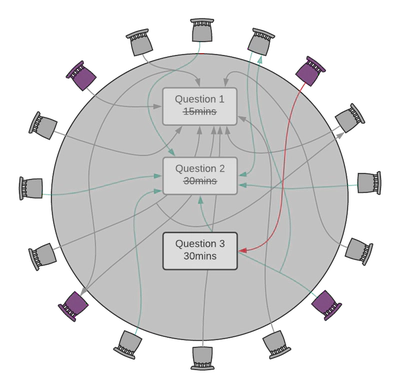Vlog 1: introducing a personal challenge
What does an inclusive and successful online event look like? Setting a personal challenge
[The short version rather than the 4min vlog]
I work as a Learning Technologist, which means that I help academic staff at a university think about how to use technology to facilitate and augment their teaching and the students’ experience of learning. During the covid-19 pandemic, within the space of days my role as part of a team, was crucial to maintaining delivery of teaching and learning. This has given me the opportunity to experience and continually reflect on the use of online spaces for teaching and learning. Prior to this I have worked with Webinar technologies for 10 years. I have also organised and chaired a range of local and national online events as well as experiencing many as an attendee. Based on all this, I now have a critical mass of experience. From this position, I feel that I can reflect and because my practice is user experience focused, I want to set myself a challenge. To identify the optimal elements when creating inclusive and successful online events. The following factors will be key to this challenge:
- How power and control function in the virtual space.
- How to provide space and time for consumption of knowledge.
- How to provide space and time for collaboration (see also, White, 2021).
- How to provide space and time for discussion, while actively considering and disrupting the structures of power and privilege that stand in the way of inclusion in online spaces.
As part of this reflective challenge, I want to consider what a user experience design process looks like for an online event. I’ll base this on the Design Council’s (2015) Double-Diamond which is based on four key design principles:
- “putting people first”
- “communicate visually and inclusively”
- “collaborate and co-create”
- and “iterate, iterate, iterate”
I anticipate that this challenge will take a while to explore on this blog. Sometimes, that exploration will take the form of vlogs, sometimes short podcasts, sometimes blog posts, and sometimes drawing. Furthermore, sometimes I will look at the big picture, or conversely a micro-interaction. This is about reflecting based on depth of experience and about capturing observations as and when they happen.

A virtual event space plan inspired by White (2021). This was used as part of introductory slides for an online event. The illustrations of virtual space, as we imagined it, were designed to structure discussion and to minimise any perceived power and hierarchy. The great thing about virtual rooms is that your table and room can be larger than in real-life! If you can imagine it and draw it, you can draw your audience into that space.
References:
Design Council (2015) ‘What is the framework for innovation? Design Council’s evolved Double Diamond’, Design Council. Available at: https://www.designcouncil.org.uk/news-opinion/what-framework-innovation-design-councils-evolved-double-diamond (Accessed: 13 March 2021).
White, D. (2021) ‘Spatial collaboration: how to escape the webcam’, David White, 1 February. Available at: http://daveowhite.com/spatial/ (Accessed: 13 March 2021).